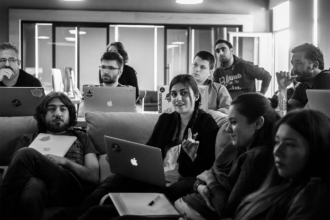What’s the most epic quitting story you’ve ever heard?
My award for most dramatic exit goes to that JetBlue flight attendant back in 2010.
After a heated exchange with a passenger, the flight attendant reached his breaking point. He swiped a couple of beers from the beverage cart, deployed the emergency slide, and glided his way to freedom. (Don’t worry, the plane had already landed.)
While the authorities weren’t too happy with his stunt, the flight attendant became a cult hero to everyone who has wanted to quit a job, but decided to grin and bear it instead.
For most of us, it’s not easy to pick up and leave. Aside from obvious pressures, like job stability, quitting has a bad rap. From a young age, we’re taught to equate quitting with failing, and that success comes from staying the course.
I think there are two ways to view quitting.
Unlike the more conventional, negative take, we can also view quitting as simply the end of one project, and the start of another.
I’m not advocating for quitting on a whim. Even when I knew that I wanted to start my business, Jotform, I stuck with my day job for two years, until I was sure I was ready to leave. And still, it was one of the most nerve-wracking (albeit the best) decisions of my life.
If you’re wondering whether to throw in the towel on a position, a project, or even a business venture, here are some techniques to help you decide with confidence.
Reframe your view of quitting

Author and entrepreneur Seth Godin has written 18 best-selling titles. Back in 2011, Godin announced that he would no longer publish books via traditional formats. Instead, he was launching the Domino Project — a novel venture with Amazon to reinvent the publishing landscape.
The Domino Project released 12 best-selling pieces of work, authored by Godin and several other writers. But less than a year after its launch, Godin made another announcement, that he would be ending the project.
Godin explained:
“By most of the measures I set out at the beginning, the project has been a success. So why stop? Mostly because it was a project, not a lifelong commitment to being a publisher of books. Projects are fun to start, but part of the deal is that they don’t last forever.”
Many may have seen the Domino Project as a failure. An undertaking that launched and fizzled within the course of a year. But Godin chose to simply view it as a project completed.
As Godin has said before, he doesn’t view quitting in a negative light. In fact, he thinks winners are smart quitters who quit often. They cut their losses and reallocate time and energy to other activities that move them forward.
By adopting Godin’s approach — seeing each venture as a project, focusing on what we’ve gained from it, and moving on — we can allow ourselves to sunset any project without feeling like we’ve failed.
Consider the opportunity costs of staying
Brothers Shep and Ian Murray had corporate jobs in Manhattan when they decided to give their two-weeks notice. They traded the security of their desk jobs to sell preppy, nautical-inspired ties and accessories out of bookbags on the beaches of Martha’s Vineyard.

Today, that venture has exploded into a $1 billion fashion brand (as valued by Goldman Sachs in 2016) known as Vineyard Vines. Fellow bootstrappers, the brothers have maintained 100% ownership of the company and have grown their team to over 2,800 employees.
Rewind to when Shep and Ian first quit their jobs, it may have seemed like the cost was high. They both left steady paychecks and company benefits in order to max out their credit cards and start Vineyard Vines.
But flip that and reverse it: the cost of staying would have been the opportunity to launch their passion project — which proved to be incomparably more valuable.
Same with Todd English, who left a lucrative desk job at a venture capital firm to co-found Kayak, which he later sold to the tune of $1.8 billion.
These highly successful quitters seem to share certain personality traits: they’re curious, risk-taking, and forward-thinking. They view quitting as an opportunity gained rather than a position lost.
When deciding whether to quit one project, don’t limit your calculations to the cost of leaving. Play devil’s advocate and consider what your current occupation is stopping you from doing.
Even if your goal is to secure a specific type of position, rather than start a business, think about whether your current gig is providing the necessary training. If not, then your opportunity cost is all the valuable skills you’ll need to land your dream job.
Crunch the numbers
We launch companies for many reasons: to realize a passion, to fill a gap in the consumer space, and to improve the quality of our lives.
But let’s face it: we also want to turn a profit. And sometimes, despite your best efforts, your current job has a ceiling; there’s a limit to how much financial success you can achieve.
That’s what led Hireology CEO and founder Adam Robinson to quit his first startup.
Writes Robinson:
“Shutting down my first startup was one of the best decisions I’ve ever made in my life. Had I not walked away, I would still be beating my head against a wall with a business that would never, ever get me to the outcomes I was seeking.”
In deciding whether it’s time to quit, Robinson recommends looking for two key economic signs:
- Business is good but you’re not making a profit
- Customers churn at an unsustainable rate
In his first startup, Robinson found the business wasn’t generating sufficient profits, even at full capacity. After taking a hard look at his business model, he discovered that customers were expensive to acquire, but they didn’t stay long enough to recover their acquisition costs. So he cashed in his chips.
Once Robinson quit, he freed himself up to start his second startup — and he never looked back.
Decide if your heart’s still in it
When celebrated author Sherwood Anderson decided to quit the corporate world and dedicate himself to writing, he penned a rather unusual resignation letter composed entirely in the third person. In the final paragraph, he wrote:
“Anderson is not really productive. As I have said his heart is not in his work. I think he should be fired and if you will not do the job I should like permission to fire him myself… He is a nice fellow. We will let him down easy but let’s can him.”
Though the letter is remarkable for its cheeky sense of humor, Anderson raises a crucial point: passion.
Some people might say passion is impractical. It’s a luxury for us to feel passionate about our work, not a necessity.
But, as numerous studies (and my own experience have shown), being inspired and engaged by your work doesn’t just make it more enjoyable; it also increases customer satisfaction and your company’s overall chance of success.
That’s not to say you have to love every aspect of your job. As a startup founder, I’ve had to wear (or at least try on) every hat in the business, and I can’t say I’ve loved them all equally. But I am passionate about making people’s lives easier and organizations more efficient, so I’m content knowing that every day, no matter the task, I’m working toward that mission.

Even if you work for the world’s most prestigious company, it’s important to consider whether the day-to-day experience still makes you happy. For example, one former Apple designer landed what he thought was his dream job, before realizing that the actual work made him miserable. Among other things, he had a micromanaging boss, unproductive daily meetings, and long, inflexible hours — so he promptly quit.
Looking back on his decision, the designer, Jordan, explains:
“[One] morning I got up a bit later than usual, and I missed the one Apple bus that stops by my house. I ended up driving to work in slow traffic. I was thankful I didn’t have to drive every day. But I was still thinking that I’d rather be taking my daughter to her preschool like I did on some mornings before I started at Apple.”
Some people might think that Jordan abandoned the chance of a lifetime. Given the same circumstances, I probably would have quit, too. Family time is my top priority, and it’s something I wouldn’t sacrifice for any company or position.
And if one opportunity isn’t making you happy, the next one might. So don’t be afraid to take the Seth Godin approach. Declare your current project finished and move on.
If you need an extra push, one study from Northwestern University demonstrated that people who discard unrealistic goals and switch to alternate goals are happier, physically healthier, and less stressed.
Still, it can be tough to stop seeing quitting as failure, and to prioritize our own happiness. That’s why Dr. Kristin Neff, an associate professor at the University of Texas, recommends acting as if you’re advising a loved one. We tend to be more emotionally generous when we’re giving advice to others.
Chances are, you’d tell a close friend or family member to do what makes them happy. And if their current position or project is no longer enjoyable, you would encourage them to find something new.
Quitting, not resigning to failure
Hindsight tends to make every decision seem easier, especially when they end with success stories. Looking back, it may seem like the Todd Englishes, the Murray brothers, and the Sherwood Andersons of the world probably had no trouble deciding to quit their jobs.
Ahead of them were incomparably more profitable, more satisfying opportunities.
But in the moment, quitting is never easy. I still remember my shaking hands and thumping heart as I walked to my boss’ office to resign. It wasn’t as newsworthy as the disgruntled flight attendant, but it changed my life and allowed me to take Jotform to the next level.
So if you’re deciding whether to quit, know that it’s always a difficult decision, and if you do resign, that you’re not resigning to failure.
Be as kind to yourself as you would be to a loved one, and remember: you may be paving the way for your best opportunity yet.







































































Send Comment: